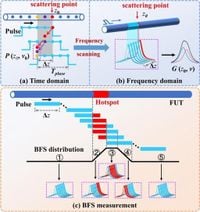In recent research, scientists have introduced an innovative temperature demodulation scheme known as the slope-assisted Brillouin frequency shift (SA-BFS), significantly enhancing measurement capabilities in optical fiber sensing technologies. Traditional Brillouin optical time domain reflectometry (BOTDR) has long been constrained by pulse width limitations—specifically, a nominal spatial resolution tied to the length of the event being monitored. However, the SA-BFS technique allows for precise measurement of sub-pulse-length event zones on a 10.2 km sensing fiber.
The team, led by researchers from various institutions, successfully demonstrated that the new method can effectively reduce the measurement capability from 2 meters to an impressive 0.49 meters. This advancement promises to revolutionize applications in structural health monitoring and industrial temperature detection. The technique achieves temperature demodulation with a remarkable accuracy of approximately 57.75 °C, which is ten times superior to conventional demodulation methods.
In traditional BOTDR applications, the length of event zones must exceed the effective pulse width, which often results in significant measurement errors for smaller zones. However, the inventive SA-BFS method leverages the slope of the Brillouin frequency shift distribution to provide a more reliable measurement without complicating the system or prolonging data processing times.
The experimental setup involved applying a narrow-linewidth laser with a power increase to produce a peak pulse power of 479.2 mW. The researchers utilized a 20 ns pulse width, successfully measuring a hotspot of 0.49 m in length. Traditional methods would typically yield only a significant variation of 3.43 °C; in contrast, the SA-BFS technique revealed a stunning capability to detect minute changes with unparalleled precision.
Compared to prior methods that reduced pulse width through multi-pulse techniques, the SA-BFS scheme simplifies the process, eliminating the need for complex modifications to the system setup. By establishing a linear relationship between the slope of BFS and temperature through analytical models and experimental validation, the team further solidified the reliability of this new technique.
Experiments indicated that as the pulse moves into an event zone, the interaction dynamics between the probing light and the fiber’s material properties generate a unique Brillouin signal profile, pivotal for temperature measurement. Researchers noted the striking impact of temperature on the rate of frequency change, resulting in a linear correlation with the slope of the BFS curve.
The versatility of the SA-BFS approach suggests broad future applications in various fields requiring accurate temperature or strain monitoring. Its adaptability renders it a valuable tool in distributed optical fiber sensing technologies, allowing for operational integrity in scenarios ranging from geotechnical monitoring to infrastructure assessments.
The significant improvement in measurement accuracy and resolution achieved by the SA-BFS method could pave the way for advancements in various fields reliant on internal sensing capabilities, opening doors for innovations in engineering, safety monitoring, and environmental protection.
Ultimately, the results of this study, published on March 20, 2025, in Scientific Reports, not only illustrate the potential of this innovative approach to enhance the performance of existing optical fiber sensors but also highlight the transformative impact that precision measurement techniques can have on future technological applications.




